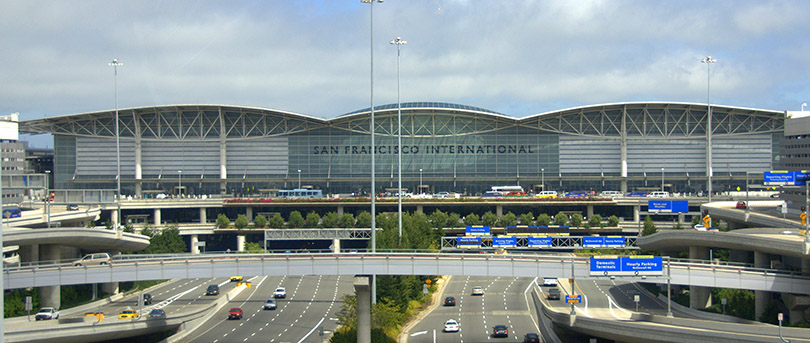
San Francisco International Airport; (c) Constantine Kulikovsky/Wiki Commons
San Francisco Transportation
Airport
San Francisco International Airport (SFO) is a busy international airport. If you have an hour or longer layover before queuing to board, consider visiting art galleries between each terminal. The architecturally bold International Terminal has many such rewards. Like every world-class airport, SFO features an array of restaurants, cafes, lounges, coffeehouses, gift shops, restrooms, wifi, business services, and nearby hotels.
Navigating the circular 4-terminal airport is easy using this SFO Airport Terminal Map.
AirTrain Automated People Mover circulates outside all terminals and stops at BART-SFO Transit Station and SFO Rental Car Center. Travelers commuting to San Francisco or Oakland should exit AirTrain at BART SFO Station, then walk down one level to catch the BART Dublin-Pleasanton Train.
Travelers commuting southbound should pay $4 to ride a different BART SFO Station train to BART-Caltrain Millbrae Station. Upon arrival at Millbrae Station, locate the vending machine and purchase a Caltrain ticket headed to a southbound destination on San Francisco Peninsula.
At SFO Airport, hail a taxi at the lower level of terminals in the middle island. Super Shuttle (415-558-8500) travels all over the San Francisco Bay Area. For Car Rentals, follow signage from your arrival terminal to AirTrain Station. AirTrain goes to/from SFO Car Rental Center, which hosts Alamo, Avis, Budget, Dollar, Enterprise, Hertz, National, and Thrifty brands.
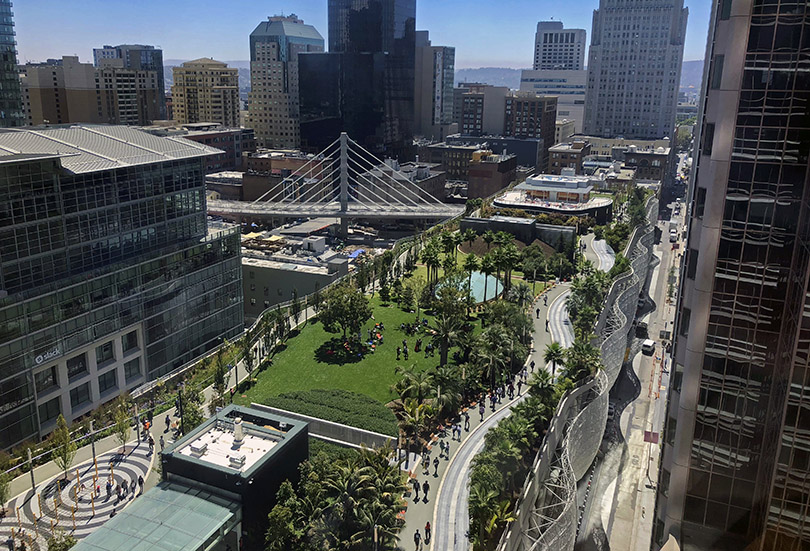
Rooftop park on Salesforce Transit Center, San Francisco
Train Station
Located 1 block from BART and Muni Metro rail systems and 3 blocks from the Ferry Building, Amtrak shuttle bus runs from San Francisco’s Salesforce Transit Center across the bay to Oakland Amtrak Station at 245 2nd Street in Jack London Square. From there you can board these Amtrak routes:
Capitol Corridor: Auburn-Sacramento-Emeryville-Oakland-San Jose
San Joaquin: Oakland-Emeryville-Stockton-Merced-Fresno-Bakersfield
Coast Starlight: Los Angeles-Oakland-Sacramento-Portland-Seattle
California Zephyr: Chicago-Omaha-Denver-Sacramento-Emeryville
Amtrak Capitol Corridor runs 15 daily roundtrips, daily. Amtrak San Joaquin runs 6 daily roundtrips. Amtrak Coast Starlight and Amtrak California Zephyr are long-distance trains that run 1 daily roundtrip. With advance reservation, Amtrak provides wheelchair lift assistance for all trains. All trains feature a cafe car, quiet car, bike space, and WiFi. Long-distance trains include a reservations-only dining car with the wait staff.
The magnificent Salesforce Transit Center in downtown San Francisco connect rapid buses, regional buses, tour buses, Greyhound, Megabus, Amtrak shuttles and taxis. By 2030-ish, a tunnel is slated to open to Salesforce Transit Center, permitting Caltrain to arrive.
A few years later, California High-Speed Rail will interconnect San Francisco, San Jose, Fresno, Bakersfield, Palmdale, Burbank Airport, Los Angeles, Norwalk, Fullerton, and Anaheim.
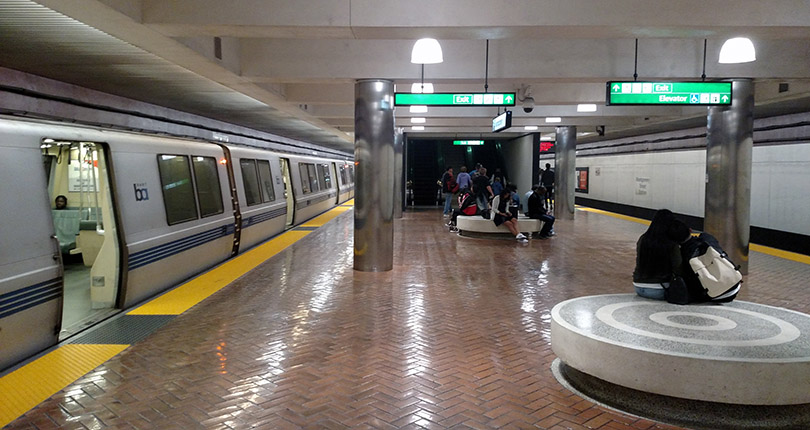
Train at BART Market-Montgomery Station; credit Soul Of America
Rapid Transit
Opened in 1972, BART (Bay Area Rapid Transit) has expanded to a 109-mile, 46-station Metro heavy rail system that runs in subway, under San Francisco Bay, and on aerial tracks. BART trains are never disrupted by automobile traffic and reach 80 mph during the 7-mile dash under San Francisco Bay.
Pre-pandemic, BART transported 435,000 commuters in 5-minute Rush Hour frequency and at 12-minute Night-time frequency. Like many Rapid Transit systems worldwide, it is struggling to recover pre-pandemic ridership levels.
Bicycles are permitted on BART during the mid-day, night-time, and weekends. Since station floors are even with train floors and each station has elevators, BART is wheelchair accessible. BART LED displays and audible messaging tell you when the next train arrives. All BART trains run through Oakland. The BART Berryessa/North San Jose-Richmond line does NOT go to San Francisco.
Notice that BART System Map uses endpoint line names:
• Richmond-Daly City/Millbrae
• Warm Springs-Daly City
• Pittsburgh/Bay Point-SFO
• Dublin/Pleasonton-Daly City/Millbrae
• Berryessa/North San Jose-Richmond
If you are familiar with Metro system ticket dispensers in NYC, Los Angeles, Chicago, Washington, Philadelphia, Boston, Atlanta, Baltimore, or Miami, you’ll easily grasp the same approach for BART ticket dispensers. Otherwise, spend a 2 minutes watching this “How To” video.
Since BART commuters may travel up to 40 miles in one direction, the highest one-way fares reach $8. Better yet, purchase a discounted Clipper Card to interchangeably travel on all transit modes in the San Francisco Bay Area. BART hours of operation are:
Weekdays: 4:15a-1:00a
Saturdays: 6:00a-1:00a
Sundays: 8:00a-1:00a
Transfer underground from BART to Muni Metro at any of four (Embarcadero, Montgomery, Powell, Civic Center) downtown BART-Muni Metro stations. Transfer from BART to ferries by deboarding at Embarcadero Station, then walk 2 blocks east to the Ferry Building.
Think you’ll feel queasy riding BART 7 miles under the San Francisco Bay? History suggests there is little reason to worry. When the 1989 Earthquake disabled San Francisco-Oakland Bay Bridge, the well-engineered BART system continued running. Like other aging Metro systems, however, it can be delayed by occasional mechanical/electrical failures. To the relief of commuters, BART is currently upgrading electrical systems, replacing worn tracks and old transit trains.
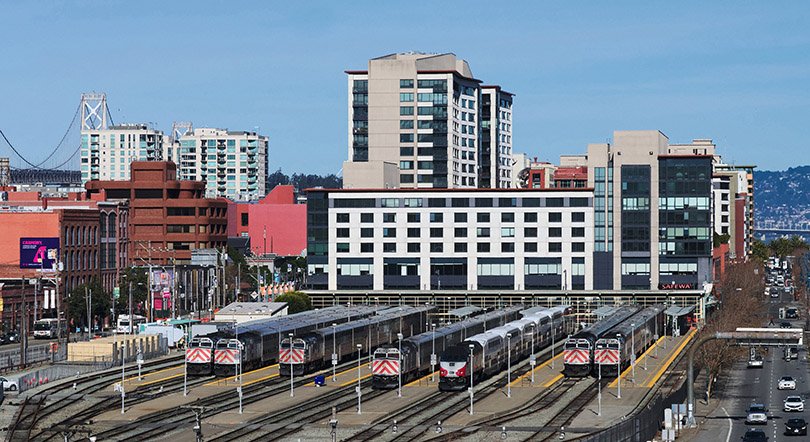
Caltrain Station at 4th & King Street, San Francisco; Wiki Commons
Caltrain commuter rail has a spartan 4th & King Station near AT&T Baseball Park, but 1.3 miles south of downtown. Service runs every 20 minutes during commute hours in its 47-mile journey down the San Francisco Peninsula. Caltrain has overhead passenger luggage racks and runs up to 79 mph between San Francisco and San Jose.
Caltrain also has limited-stop trains during commute hours. When you look at this Caltrain System Map, consider that Millbrae, Burlingame, San Mateo, Redwood City, Palo Alto, Mountain View, Sunnyvale, Santa Clara, and San Jose Diridon are popular stations with nearby amenities and transit connections.
Millbrae Station allows Caltrain commuters to transfer to a BART train that goes to SFO Airport. You can also transfer (with a different ticket) to Amtrak trains at Santa Clara and San Jose Diridon Stations.
In fall 2024, Caltrain will transition from diesel powered to electric powered trains that do not emit smog or greenhouse gases. The new trains will have a safety control system that brakes faster when people or objects are on the tracks. Trains will accelerate faster enabling more frequent service. They will also have more capacity, better seats, ADA-accessible restrooms, and more space for bikes.
San Francisco Municipal Railway, locally called Muni Metro, started as a streetcar system in the 1890s with most surface track shared with automobiles. In 1980, larger capacity light rail trains replaced streetcars, and a new tunnel under Market Street connected with two old streetcar tunnels.
When riding Muni Metro, you experience its evolution from streetcar to light rail system. Muni Metro System Map indicates six Muni Metro lines that run from 5a-12p Sunday-Thursday and until 1a on Friday-Saturday:
J Church: Balboa Park-City College-Castro District-Market-Embarcadero
K Ingleside: Balboa Park-Church Street-Castro District-Market-Embarcadero
L Taraval: SF Zoo-West Portal-Van Ness-Market-Embarcadero
M Ocean View: San Jose-Geneva-Stonestown-Market-Embarcadero
N Judah: Ocean Beach-Judah-UCSF-Market-Embarcadero-4th & King
T Third Street: Chinatown-Market St/Union Square-Moscone Center-4th & Brannan-4th & King-Mission Bay-3rd St/Bayview-Sunnydale
Automatic ticket dispensers are on each underground station and surface station platform. If you board from a surface station, remember that you must be prepared to present a ticket when asked by Muni attendants who check trains.
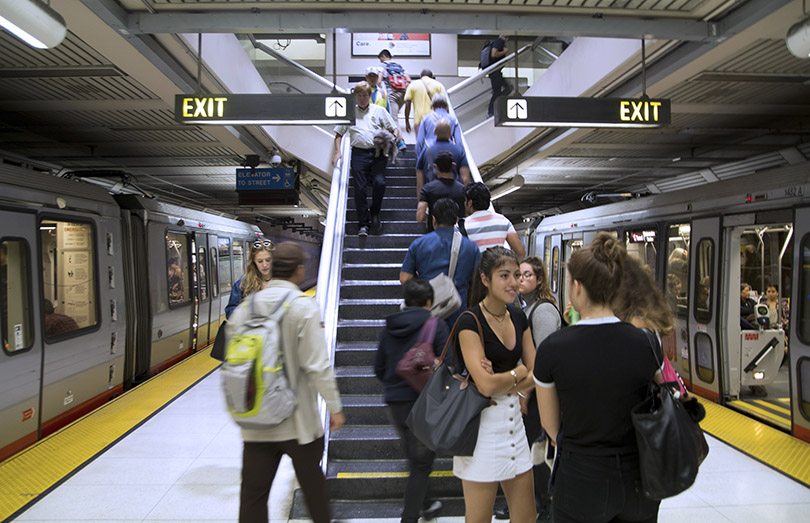
Muni Metro trains at Market-Van Ness Station; (c) Soul Of America
Most Muni Metro lines run underground through Market Street Tunnel and share four stations (Embarcadero, Montgomery, Powell, Civic Center) with BART. Those Muni Metro tracks are one level above BART. Depending on their route, Muni Metro lines use 2 to 5 additional underground stations (Van Ness, Church, Castro, Forest Hill, West Portal). Only N and T lines surface on The Embarcadero southbound to AT&T Baseball Park and Caltrain 4th & King Station. From 4th & King Station, the T line continues southbound in the Third Street corridor.
When Muni Metro N, M, L, K, and J lines emerge on the surface, they often share streetcar lanes with autos and stop every 2 blocks for an agonizingly slow 10 mph average speed. Muni Metro T line trains run in the Central Subway Tunnel and on transit-only surface lanes with stops every 4-5 blocks for faster speed.
Muni Metro passengers from other J, K, L, M, N lines and BART can transfer to Muni Metro T line at Market St/Union Square Station for travels to Chinatown, Moscone Convention Center, Chase Center Arena/UCSF and Bayview-Sunnydale. In 2022, Muni Van Ness Bus Rapid Transit (BRT) line opened on Lombard Street and Market Street connecting with the Muni Metro lines at Market & Van Ness.
In late-2023, Muni Metro hopes that higher ridership justifies boosting trains to 5 minute Rush Hour frequency and 10 minute Night-time frequency again.
Muni Vintage Streetcars are fully restored and imported from Italy, England, Russia, Australia, Japan, Germany, Portugal, and nearly a dozen domestic cities. These hand-crafted conveyances travel at 9-10 mph, which is perfect for casually observing attractions along the way. The price is $2.50 per ride with free transfers that last 90 minutes from purchase.
F Line: AT&T Baseball Park-South Beach-Ferry Building-Exploratorium-Cruise Terminal-Pier 39-Fisherman’s Wharf
E Line: Castro District-Market Street-Ferry Building-Exploratorium-Cruise Terminal-Pier 39-Fisherman’s Wharf
Vintage Streetcar patronage in San Francisco has become as popular as Cable Cars. We highly recommend taking Muni E Line Streetcar runs from anywhere on Market Street to the Embarcadero and Fishermans Wharf, where it circles back.

Cable Car at Market & California, San Francisco; (c) Soul Of America
Opened in 1873, Muni Cable Cars are one of the few moving National Historic Landmarks in America. Even at $5 per ride, these treasured relics are worth it for exhilarating views of steep San Francisco hills. When you board, watch drivers get a workout applying the heavy grip on the underground cable moving at 9 mph. Before you exit the vehicle, wait until the driver ungrips the cable, sets the brake to a full stop, and rings the bell. Watch for autos and only use the designated crosswalk at street intersections. The Green X sidewalk signal is “Go” for cable cars, not pedestrians.
The Cable Car Museum at 1201 Mason Street, shows the powerful cable gears at work. Though not indicated on the Cable Car Map, all three routes provide awesome vistas, entertaining bell-ringers and come within 1-3 blocks of the Cable Car Museum:
Powell–Hyde: Powell & Market, Union Square, Nob Hill, Fishermans Wharf
Powell–Mason: Powell & Market, Union Square, North Beach, Fishermans Wharf
California Street: Market & Embarcadero Center, Financial District, Chinatown, Nob Hill, Van Ness
The combination of BART, Muni Metro, Vintage Streetcars, and Cable Cars travel within 3 blocks of most city attractions. Also, Clipper Card is a reloadable smart card for electronic transit fare payment on all San Francisco Bay Area modes of transit, including ferries.
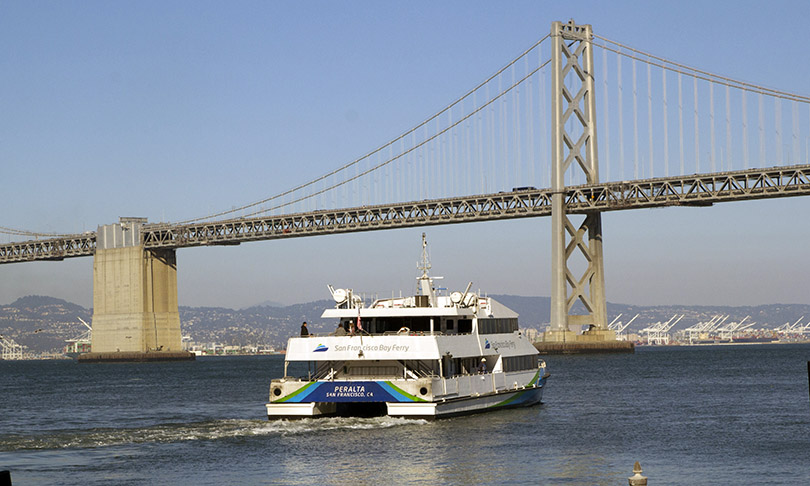
San Francisco Bay Ferry headed to the Bay Bridge; (c) Soul Of America
Cruiseport
San Francisco Ferry Building on the Embarcadero faces Market Street. Ferries provide break-taking views of bay while traveling between San Francisco, Oakland, Alameda, Larkspur, Vallejo, Richmond, AT&T Baseball Park, and South San Francisco. Their daily routes are frequent during Rush Hours. Check the website for fare prices. Frequent ferry riders purchase a discounted Clipper Card.
Red & White Fleet Ferries
DESCRIPTION: In business since 1892, San Francisco’s oldest ferry line features audio tour headsets and three unforgettable bay cruise routes:
• Golden Gate Bay Cruise, 1 hour under the Golden Gate Bridge and around Alcatraz, it is San Francisco’s only bay cruise in 12 languages, departs 8–14 times daily; we recommend this cruise for views that you’ll remember a lifetime.
• SF Explorer Cruise, the 90-minute cruise that offers spectacular views and narratives on Natural History, Architecture, and Native American Culture; departs May-Sept
• California Sunset Cruise, a 2-hour twilight sail with hearty appetizers and guitar music, April-October
San Francisco Cruise Port at Pier 27 and 35
DESCRIPTION: Prior to 1991, major cruise lines rarely docked at San Francisco’s port that was blighted by a doubled-deck freeway. Then demolition of Embarcadero Freeway followed by The Embarcadero Roadway and Pier Facade beautification projects led to a modest clean-up of Pier 35.
Today it hosts ~80 cruise ship calls annually by Carnival, Royal Caribbean, Princess, Celebrity, NCL, Holland America, Cunard and Silversea. They utilize San Francisco as a Port of Call for routes to Alaska, Vancouver, Seattle, Los Angeles, San Diego, Mexico Riviera and Hawaii. Since the cruise industry is upgrading to larger (3000-4000) passenger ships on the Pacific Coast, San Francisco upgraded Pier 27 to host with an attractive terminal with public plaza passenger amenities that open to The Embarcadero for ground-to-ship vistas. Pier 35 is now a supplemental port to dock large cruise ships simultaneously with large cruise ships docked at Pier 27.
ADDRESS: Pier 35 and Pier 27 on The Embarcadero.
TRANSIT: Muni Metro F-Line stop at The Embarcadero & Greenwich Street
PARKING: City Park garage at 80 Francisco Street and Ace Parking at 55 Francisco Street & The Anchorage Center
PHONE: Contact the cruises lines for their respective ship info
WEBSITE: Link
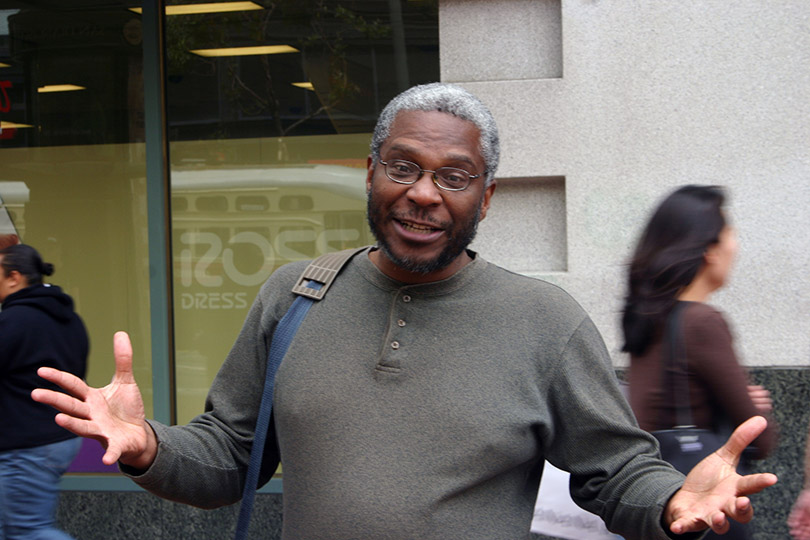
Historian and Black San Francisco Tour Guide John Templeton; (c) Soul Of America
Tours
Black San Francisco Tours
DESCRIPTION: Take a guided tour through 220 years of the Black Experience in San Francisco with John William Templeton, author of Our Roots Run Deep: the Black Experience in California; Templeton offers a Downtown guided tour, all-city excursions and Original Jazz Clubs of the Barbary Coast in San Francisco Tour. Templeton will give you the real deal on San Francisco’s history with a surprising backstory.
PRICING: walking tours $15, motor tours $35
ADDRESS: contact Templeton for a meeting place and details in San Francisco
PHONE: 415-240-3537
WEBSITE: http://www.californiablackhistory.com
Victorian Home Walk Tour
DESCRIPTION: Experienced tour guides have shown visitors to SF’s world-famous architecture for over 14 years. For 2.5 hours, they go where tour buses are not allowed, without hills. They hold a yellow sign that says “Victorian Home Walk”; arrange a private tour for 10 or more. They include transportation to Pacific Heights, a stroll through the best Victorian neighborhoods, and a visit inside a Queen Anne Victorian house.
PRICING: $25 per person, no credit cards; fee collected at end of the tour
ADDRESS: San Francisco; departs 11a daily from Union Square; no reservations required
PHONE: 415-252-9485
WEBSITE: http://www.victorianwalk.com
Urban Trek USA
DESCRIPTION: Features four different walking tours that are environmentally friendly and enable guests to understand why San Franciscans love their city so much. Points of interest include Union Square, Chinatown, Jackson Square, North Beach, Telegraph Hill, Levis Plaza, and the Ferry Building.
PRICING: $30 per person
ADDRESS: San Francisco; 900 Market Street in the lower level of Hallidie Plaza
PHONE: reservations required 415-265-8229
WEBSITE: http://www.urbantrekusa.com
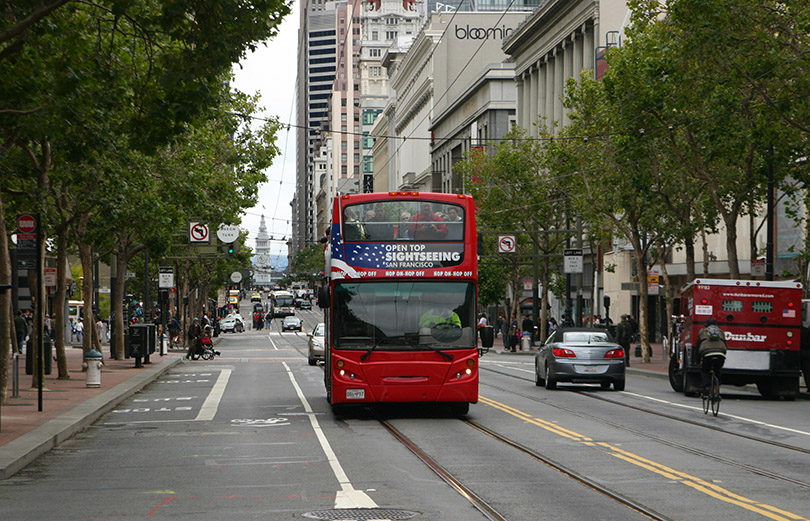
OpenTop CitySightseeing Tourbus on Market Street; (c) Soul Of America
CitySightseeing San Francisco
DESCRIPTION: The original open-top, English double-decker tour bus company in San Francisco offers hop-on/hop-off tours. Experienced tour guides in the upper deck provide insights about each attraction. Start with the 1.5-hour San Francisco Downtown Loop. If so inclined, add the Golden Gate Bridge + Sausalito Loop or Golden Gate Park Loop or Night Tour on the same day. If you really hate driving on steep hills and the hassles of parking, sample area attractions with the 4-in-1 All Loops Tour for the best value over 48 hours. You can also bundle trips to Alcatraz, Wine Country, Muir Woods, Yosemite, San Francisco Segway Tours, and GPS-guided GO Cars.
PRICING: buy online for discounts – San Francisco Downtown Loop $25 Adults, $16 Child; 4-in1 All Loops Tour $50 Adult, $28 Child
DEPARTS: Daily 9a-5p, every 10-20 minutes at 18 locations
ADDRESS: begin at 2800 Leavenworth Street MAP
TRANSIT: only one block from Muni Vintage Streetcar to Fisherman’s Wharf station or the Fisherman’s Wharf turnaround for Powell & Hyde Cable Car
PHONE: 415-440-8687
WEBSITE: http://www.city-sightseeing.us
GoCar
DESCRIPTION: A clever storytelling GPS-guided mini-car that gives you an open-air touring experience unlike any other. Select from 5 languages that guide you to the major attractions of San Francisco. The two-seated, three-wheel vehicles fit in the tightest places that a bus tour can not touch. It’s eco-friendly too.
PRICING: 1st hour $49, 2nd hour $39, each additional hour $29, No further charge after 5 hours
ADDRESS: San Francisco; pick-up/drop-off at 2715 Hyde Street or 321 Mason Street
PHONE: 415-441-5695
WEBSITE: http://www.GoCarSF.com
Bike and Roll San Francisco
DESCRIPTION: Take a beautiful bicycle ride on the Bay Trail over the Golden Gate Bridge to Sausalito with a return trip to San Francisco by ferryboat! The tour is an easy 9-mile adventure as most of the ride is flat and the last 3 miles are downhill. Sights of interest include Fisherman’s Wharf, Aquatic Park, Ghirardelli Square, Fort Mason, Palace of Fine Arts, the Presidio, Fort Point, the Golden Gate Bridge, Sausalito shops, Alcatraz and Angel Island.
PRICING: Begins at $10 per day
ADDRESS: 899 Columbus Avenue, San Francisco
PHONE: 415-229-2000
WEBSITE: http://www.bikeandroll.com
Freeways & Bridges
San Francisco Freeway Network is well developed in terms of traffic status signs, carpool lanes and metered entrance ramps. Traveling westbound on San Francisco-Oakland Bay Bridge (locally called “Bay Bridge”) remains crowded during commuter hours. When traveling westbound on the Bay Bridge, you pay a toll. Traveling eastbound is FREE. Avoid traffic tickets, DO NOT USE Bay Bridge Fastrak lanes without a pre-paid toll transponder on your vehicle. Some car rental agencies include them for a fee.
